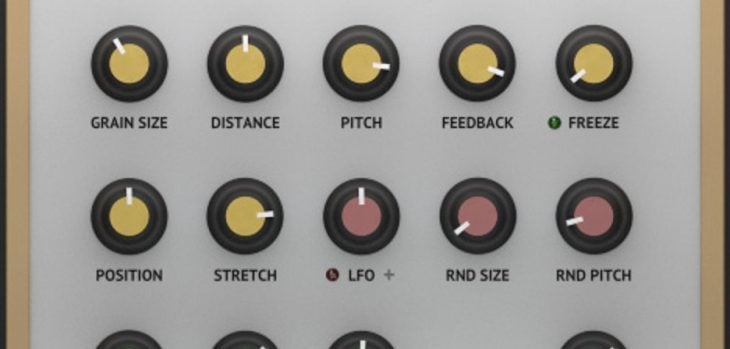There are two basic methods of “granular synthesis”. First, there are granular samplers that process pre-recorded audio, then there are granular effects that process live audio. GrainSpace from Audiority is among the latter of the two categories, and when you compare it to those in its class, it easily outranks its peers in regard to the sheer amount of control you have over the behavior of the grain stream.
Most granular processors have basic controls for determining grain size and distance between grains, and perhaps some feedback and pitch shifting controls, but your options are usually pretty limited. Fortunately, GrainSpace offers a wide array of controls, including a time Stretch algorithm (which I’ve actually never seen within a granular processor), a sophisticated tempo-syncable Freeze algorithm (more on that later) and the ability to shift the Position of the grain window within the delay buffer, which is something you see all the time in a granular sampler, but hardly ever in a granular effect plugin.
You also have a small handful of “grain modulators”, including a dedicated LFO with four modulation targets (Size, Stretch, Position and Pitch) and a “+” button that switches between unipolar and bipolar modes. Just to the right of the LFO knob are two controls for randomizing the size and the pitch of each grain, which is something we granular nerds often refer to as “spray” or “jitter”.
(Important note: the developer is seriously considering grouping these controls into a “Grain Modulators” section with more modulation sources, so we can look forward to that!)
The Freeze control is either “On” or “Off” or synced to your host application’s project tempo. When set to “On”, the Freeze algorithm will loop the internal buffer, which is really cool because you can use the grain parameters to travel inside the recorded audio in lots of fun ways. Synced values are basically using a smoothed square waveform to switch the Freeze control on and off, which will produce some rather interesting gated effects suitable for rhythmic content.
The green post-processing knobs allow you to Smear the grain stream with a daisy-chain of all-pass filters or attenuate the mix and volume of the granulated signal…and finally, there’s the Reverb, which is a very nice, natural sounding reverb algorithm — but if there’s any constructive criticism I have for GrainSpace, I think I would like to see the grain controls influence the reverb in some way so it feels more “infused” with the grain engine. For now, the reverb feels like kind of an afterthought, even though I’m very happy with the reverb itself, which also happens to be one of the best plate reverb algorithms I’ve laid ears on.
There’s been a considerable amount of buzz surrounding GrainSpace’s similar design to “Clouds”, a popular granular hardware processor manufactured by Mutable Instruments, but I can assure you that GrainSpace (albeit partly inspired by Clouds) is a completely original software with original source code having nothing to do with Mutable Instruments’ open-source code, so we can put that rumor TO BED, even though GrainSpace’s architecture is somewhat based on principles derived from Ross Bencina’s “Implementing Real-Time Granular Synthesis” paper published in 2001, which has provided a starting point for many developers who’ve made similar effect plugins in the last sixteen years.
IMPORTANT NOTE: Before you read this next bit, I want to make it perfectly clear that what I’m about to describe is not in any way, shape or form a bug or a design flaw; it’s simply an issue that the developer is currently working on. Some people got the impression that GrainSpace is “glitchy” or malfunctioning in some way. THAT IS NOT THE CASE! GrainSpace just so happens to be my favorite effect plugin so far this year, so please don’t take this next line of criticism as a red flag…
Currently, there is a problem (having something to do with phase correlation) that tends to crop up when using the Position and Stretch controls, but before I muck up the description of said problem, I’ll just quote the developer Luca Capozzi: “It might sound glitchy due to the offset change when working with Position and Stretch, especially on negative values. We are working on a de-glitcher that will be implemented as an option in future updates.”
That being said, there are a good number of presets included in the factory soundbank and also quite few wonderfully weird textures crafted by Richard Devine and Alessandro Romeo that put these “glitches” to perfectly good use, so I’m pleased that this up-and-coming de-glitcher will be offered as “optional”.
The Verdict
For a good long while, I’ve been on the prowl for a simple (and affordable) real-time granular processor that offers a considerable amount of control over the grain stream. While I definitely suggest a resizable vectorized GUI at some point, I’m very happy with the overall look and feel of GrainSpace, which has become my go-to granular processor of choice in a very short amount of time.
Audiority GrainSpace Review
For a good long while, we’ve been on the prowl for a simple (and affordable) real-time granular processor that offers a considerable amount of control over the grain stream. GrainSpace seems to fit the bill!
-
Features8
-
Workflow10
-
Performance9
-
Design8
-
Sound9
-
Pricing10



2 Comments
marti garaughty
onReally nice demo, this will be great for ambient music production!
Xenos Soundworks
onI just picked this up on sale at PluginBoutique for only $22 bucks and can already see it’s gonna get a lot of use. Personally, I wouldn’t use it like a conventional reverb, but for sound design and special effects type projects, it’s an absolute gold mine. Now that it’s been updated with more features in version 2.0, you can really dig in and get some nice pulsating/undulating soundscapes out of it.